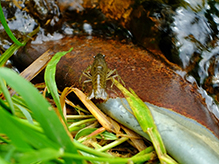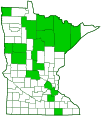virile crayfish
(Faxonius virilis)
Conservation • Description • Habitat • Biology • Distribution • Taxonomy
|
|
||||||||||||||
Description |
Virile crayfish is a medium- to large-sized freshwater crustacean. It is widespread and abundant across North America. It is native to central United States and Canada from Quebec to Tennessee in the east to Alberta and Colorado in the west. It is introduced and considered invasive outside of its native range from coast to coast. Adults are 1¾″ to 5″ long and smooth. Males are usually larger than females. Occasionally, an individual will be entirely bluish. The abdomen and the shield (carapace) covering the front part of the body (cephalothorax) are olive-brown dappled with dark brown. The long spike-like extension of the carapace that projects forward between the eyes (rostrum) has straight, more or less parallel sides. There is a pair of dark brown splotches on the upper (dorsal) side of abdominal segments 1 through 5. The claws (chelae) are broadly flattened and usually bluish with numerous yellow bumps (tubercles). They do not have black bands at the tip. The movable finger (dactylus) on the claw has a straight margin. The legs are usually bluish with yellow tubercles. |
Size |
Total length: 1¾″ to 5″ |
Similar Species |
Habitat |
A variety of lakes, streams, and wetlands |
Biology |
Season |
Most active May to September |
Behavior |
They prefer streams with rocky bottoms, moderate flow and turbidity, abundant cover, and stable water levels. They often use rocks, logs, or other organic debris as cover. They occasionally dig burrows into muddy banks, especially when water levels are low. To survive the winter, they migrate to deeper water that does not completely freeze and they become inactive. |
Lifespan |
3 to 4 years |
Life Cycle |
Breeding takes place in the fall or early spring. The female stores the sperm, sometimes for months, and fertilizes the eggs in the spring. The fertilized eggs are attached is raspberry-like bunches to the abdominal appendages (swimmerets). They hatch in one to two months. They moult several times and reach maturity in their second year. |
Juvenile Food |
|
Adult Food |
Mostly dead animals, but also living snails, insects, fish, tadpoles, and plant material. |
Distribution |
||
|
Sources Helgen, J.C. 1990. The distribution of crayfishes (Decapoda, Cambaridae) in Minnesota. Final report submitted to the Nongame Wildlife Program, Minnesota Department of Natural Resources. 96 pp. Biodiversity occurrence data published by: Minnesota Biodiversity Atlas (accessed through the Minnesota Biodiversity Atlas Portal, bellatlas.umn.edu, 6/11/2025). |
|
| 6/11/2025 | ||
Occurrence |
||
Widespread and abundant |
||
Taxonomy |
|
Superclass |
Multicrustacea (typical Crustaceans) |
Class |
Malacostraca (malacostracans) |
Superorder |
Eucarida (crabs, crayfish, shrimp, etc.) |
Order |
Decapoda (crabs, crayfishes, lobsters, prawns, and shrimp) |
Suborder |
Pleocyemata (crabs, lobsters, shrimp, and allies) |
Infraorder |
Astacidea (crayfishes and lobsters) |
Superfamily |
Astacoidea (Northern Hemisphere crayfishes) |
Family |
Cambaridae |
Genus |
Faxonius |
Until recently, this species was included in the genus Orconectes. In 2017 a comprehensive review and updated classification of all the species of crayfish of the world was published (Crandall, K. A., and S. De Grave. 2017). The genus Orconectes was split into two groups. Cave dwelling members remain in the genus Orconectes. Surface dwelling members were placed in the resurrected genus Faxonius. |
|
Subordinate Taxa |
|
|
|
Synonyms |
|
Cambarus couesi Cambarus debilis Cambarus virilis Cambarus wisconsinensis Orconectes virilis |
|
Common Names |
|
eastern crayfish northern crayfish virile crayfish |
|
Glossary
Carapace
The hard, upper (dorsal), shell-like covering (exoskeleton) of the body or at least the thorax of many arthropods and of turtles and tortoises. On crustaceans, it covers the cephalothorax. On spiders, the top of the cephalothorax made from a series of fused sclerites.
Cephalothorax
The front part of the body of various arthropods, composed of the head region and the thoracic area fused together. Eyes, legs, and antennae are attached to this part.
Rostrum
The stiff, beak-like projection of the carapace or prolongation of the head of an insect, crustacean, or cetacean.
Crayfish or Crawfish?
The taxonomically correct term for members of the superfamilies Astacoidea and Parastacoidea is crayfish. "Crawfish" is a southern dialectical variant of that word. It is commonly used in the United States and is accepted American English, but it is not used outside the United States.
Visitor Photos |
||
Share your photo of this crustacean. |
||
This button not working for you? |
||
Kirk Nelson |
||
Several were crawling around a culvert that had water flowing into Wood Pond. They were about 1½ inches long. |
||
 |
 |
|
MinnesotaSeasons.com Photos |
||
|
||
|

Slideshows |
|

Visitor Videos |
||
Share your video of this crustacean. |
||
This button not working for you? |
||
|
Other Videos |
||
Northern Crayfish (Orconectes virilis?) |
About
Published on May 23, 2013 Northern Crawfish (Orconectes virilis) seems eager to migrate upstream, against the strong lotic current, during a high water event after three days of almost ceaseless precipitation. Photographed at the Turtle River State Park, North Dakota (22 May 2013). |
Crayfish - (virile crayfish I think) Who wants to get pinched? |
About
Published on Aug 3, 2014 In this video, My friend Joe is learning to catch crayfish. It was pretty funny to be there. There is some cool crayfish facts and underwater footage. |

Visitor Sightings |
||
Report a sighting of this crustacean. |
||
This button not working for you? |
||
| Kirk Nelson 6/24/2018 |
Location: Lebanon Hills Regional Park Several were crawling around a culvert that had water flowing into Wood Pond. They were about 1½ inches long. |
 |
MinnesotaSeasons.com Sightings |
||
|

Created: 7/4/2018 Last Updated: © MinnesotaSeasons.com. All rights reserved. |
